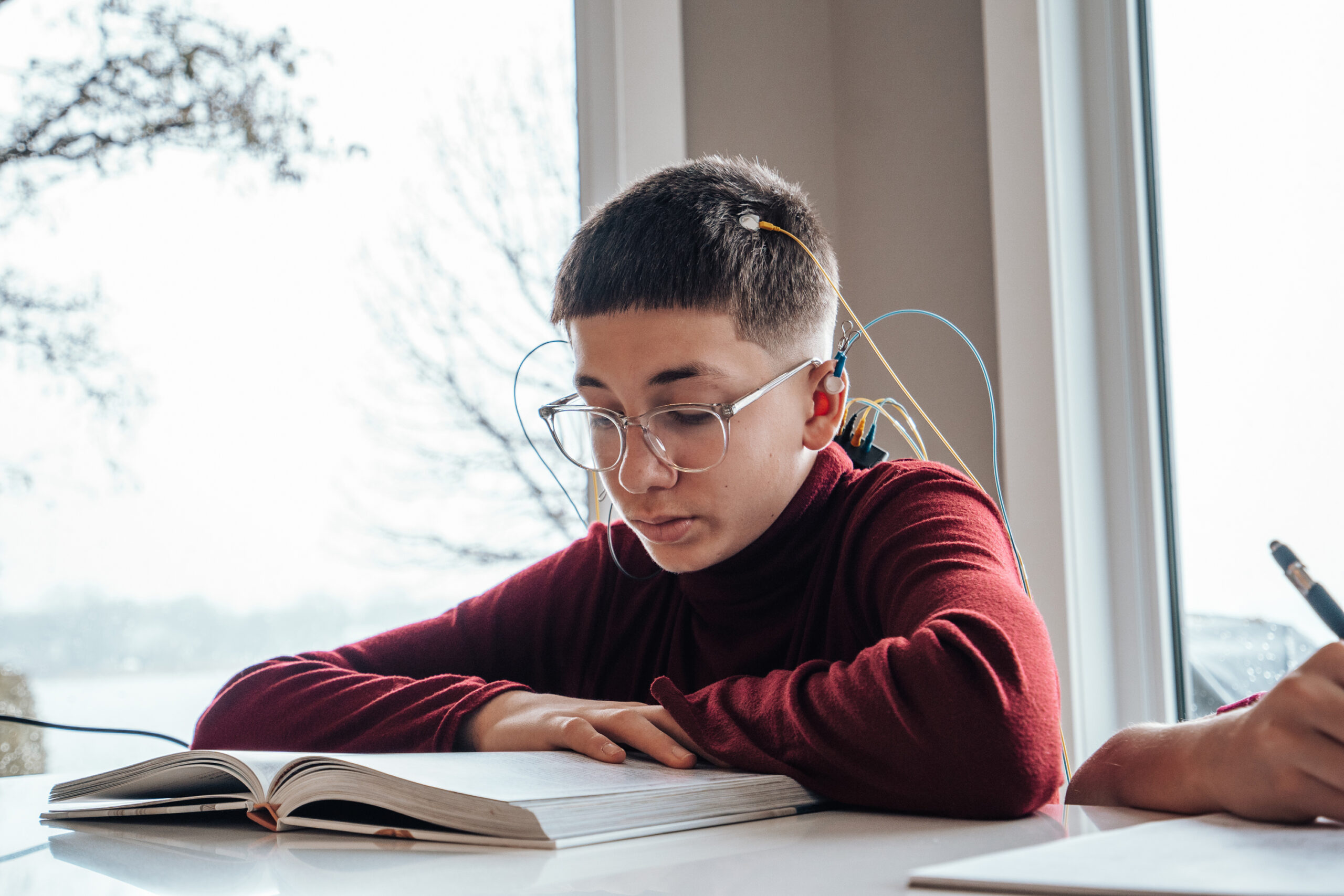In Office Sessions and Home Rental Units
RESET & RECENTER
NeurOptimal calms your mind and body so you can perform at your best.
We can’t get rid of stress but with the right tools we can help our brain and nervous system to respond with optimal resilience and balance. Even with the most balanced of mindsets, our brain and body can still suffer the effects of cumulative stress and depletion. NeurOptimal® Neurofeedback trains your brain to navigate stressors in an optimised way, letting go of stress patterns that have become unhelpful and unbalanced over time. This leaves you calm and steady so that you can perform at your best.
NeurOptimal is great for supporting you as you face into challenges as well helping you bounce back from stress and adversity. It is also very helpful for supporting peak performance and neurodivergent conditions such as Autism and ADHD.
Why Train your Brain?
How we feel, think, process information, manage stress and perform are inextricably linked to the resilience of our brain and nervous system. Sometimes we are born with a more sensitive nervous system, other times it is impacted by cumulative stress, adverse experiences or a demanding lifestyle.

The longer the you spend in stress responses, the more your brain and nervous system loose their ability to adapt flexibly and can become stuck in suboptimal states. When this happens you may experience difficulties with energy, focus, mood, sleep, anxiety, distorted thinking, information processing and decision making, amongst many others. Training your brain with NeurOptimal is an invaluable key to recovering performance and regulation.
Why NeurOptimal Neurofeedback?
NeurOptimal is completely safe for adults and children alike. It also feels wonderfully relaxing and pleasant to do.

Brain and
Nervous System
Regulation

Sleep
Physical and
Mental Recovery

Focus
Decision Making
Performance

Calm
Headspace
Clarity

Stress & Anxiety Management
Mental Health
“When I do neurofeedback it feels as if all the extra tabs that were open in my brain have closed. I didn’t even realise how much headspace they were taking up.”
M.B. – Neurofeedback client
What people say about training with NeurOptimal Neurofeedback
What NeurOptimal is Doing
NeurOptimal® training is non-linear neurofeedback. meaning it is uniquely adapting to your brain’s moment to moment activity rather than directing from a pre determined protocol. It prompts your brain to reassess its own activity and autocorrect the inefficiency of bad habits and stuck patterns. NeurOptimal is always working with your brain in real time, so each training session is completely unique and individualised.
The way your brain adapts to stress and lifestyle means it can remain stuck in inefficient habits that no longer serve you. NeurOptimal prompts a brain recalibration that helps you feel calmer and more in control so that you can improve your performance and make the changes you need to.
During the 33 minute training your brain will be working hard to train itself towards peak performance levels and you don’t have to get consciously involved in the process. You can just sit back and switch off. Most people find the process deeply relaxing.
NeurOptimal is non invasive and completely safe, so it is great for adults and children.
I offer in person sessions from the office in Hove or you can rent a system to train in the comfort of your own home.
Read more in the FAQ section below or for a deeper dive into the psychology and technical side of NeurOptimal please read my Blog Post ‘How Does NeurOptimal Work’.

‘Our job as therapists is to find out how can we help people to stop being frantic, stop being overwhelmed and to feel calm and in charge of themselves. Neurofeedback happens to be something that is very good at that.’
Bessel Van Der Kolk – Psychiatrist and author of ‘The Body Keeps the Score’
NeurOptimal Neurofeedback FAQs
How Does NeurOptimal® Neurofeedback work?
NeurOptimal® Neurofeedback encourages the brain to come back to the present in a similar way to meditation but it does it up to 256 times per second! The NeurOptimal system scans the entire brain, across all brain wave frequencies, for moment to moment shifts in electrical activity. When it detects a particular type of shift, indicating that brain is about to do something different, then it delivers the feedback as a way of disrupting the process and allowing the brain to check in with itself and decide whether it continues with its activity or not. The brain tends to work as efficiently as it can, so if it decides that it didn’t need to perform that operation after all, then it wont proceed. This system aims to disrupt habitual and inefficient activity in the brain allowing it to work much more resiliently and optimally.
NeurOptimal® is effective because it helps each individual brain re-learn to adapt moment to moment, more efficiently. It does not attempt to “fix” predetermined conditions or pin down specific problems. The heart of the NeurOptimal® system is a technology which mirrors the natural dynamical nature of the brain. This means that it isn’t telling your brain what to do, as other neurofeedback system do, it is helping your brain to get back to what it does best, homesotatic, adaptive functioning. When this happens life gets so much easier across many areas.
What happens in the session?
During the session you sit back and relax and let the system and your brain do the work for you. There is no conscious effort needed from you, even if you fall asleep the training still takes place.
Who would benefit from NeurOptimal® Neurofeedback?
This type of training helps your brain perform at its best again, whatever that best may be. The training is the same for everyone regardless of whether you come to improve sporting performance, struggles with emotions or concentration. The training doesn’t treat specific symptoms but upgrades brain and central nervous system performance through better self regulation, it can therefore bring many and varied improvements across your physical and mental functioning, even those you weren’t expecting. I had one trainee swear their parallel parking had got better!
What does Neuroptimal® Neurofeedback help with?
- Peak Performance and concentration enhancement
- Stress reduction
- Feeling grounded and present
- Emotional Resilience (ie better recovery from stress and challenges)
- Less emotional reactivity
- Less engagement with unhelpful thinking processes
- Facilitate return of veterans into home and work life
- Academic and job enhancement
- Athletic and sports training
- Optimising your intelligence with improved brain function
- Academic / learning performance: Improved focus, attention & retention, reduction of test anxiety
- Enhancing creativity and awareness
- Enriching partner, family and work relationships
Do I need to do therapy as well?
Therapy is very good for making sense of your world, your self and your expereinces, which can help you to feel better. Neurofeedback is a non verbal approach to train your brain and nervous system become more steady, regulated and resilient. It tends to help regualte deeper brain structures that cannot be accessed by talking. By calming deeper brain structures that hold our more primal fear reactions, what people gain access to is much clearer thinking and mental sharpness in the present moment.
Many people come to neurofeedback becasuse they have done a lot of therapy but still feel that their nervous sytem is unsteady and reactive. In this case neurofeedback can be the icing on the cake and deliver what therapy could not. For others, neurofeedback can prepare them for therapy or run very helpfully along side it.
How many sessions will I need?
I find that many people come to neurofeedback because they are looking for specific changes in one or two areas. NeurOptimal trains the brain as a whole, so if you are only looking for only a narrow set of results, it can be easy to miss all the other shifts and changes that occur across other areas. I encourage clients to keep an open mind about all the ‘green shoots’ of change because, even if you haven’t yet experienced the exact results you are looking for, these shifts in other areas are good evidence that change is happening and that your specifically desired results will come in time.
When you stop your training will depend partly upon your goals. If you are training to feel better quickly, you might decide after 10-15 sessions that you have made enough gains and stop. On the other hand, if you are looking for lasting changes, 25-35 sessions is a better ballpark. For some the journey will be longer still, as it was for me. For people that I see with life long struggles, I encourage them to understand the high level of internal reorganisation that is happening in their brain and that finding enduring stability after lifelong challenges will just take time. The good thing is you can stop at any time and always pick it up again later if you so choose. Any training you have done in the past will always serve you well should you do more sessions in the future — no session is ever wasted. The training and changes your brain make will be remembered, so future sessions will add to the learning and act as a good way to get back on track when life’s challenges push you off balance.
I want to optimise my performance. Can NeurOptimal help?
We all live at a faster pace and in a more complex world than the human brain developed to deal with. There are many competing demands and stresses that even the highest functioning brain will still sometimes become worn down by. It isn’t always possible to have all the recovery time our brain and body need to get back to their best. Neurofeedback is an excellent tool for resetting and sharpening our performance.
